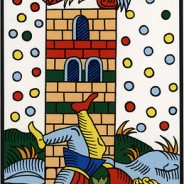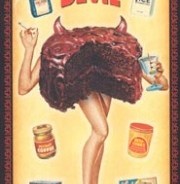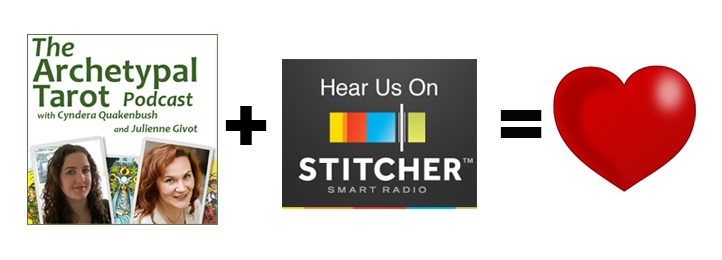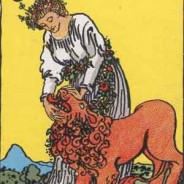The Star – Finding True North
Listen Now or Subscribe in iTunes
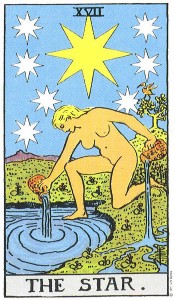
The Star card from the Raider-Waite deck.
Archetypal Tarot celebrates its 20th podcast! With some much needed respite after the tumult of the falling tower, Julienne Givot and Cyndera Quackenbush cozy up in some Dutch slippers and delve into the nourishing waters of the 17th card of the Major Arcana- The Star.
Picture the Fool (our Hero in this journey) laying on the grass in a field after the sudden liberation of the last stage. She is coming to and is not yet able to articulate what just happened to her. The symbols of the scene represented in the Star feature a naked woman who is both vulnerable and in harmony with the elements as she tends to what needs to be done.
Stripped of clothing (ego identity) and back down to the earthy basics, the beautiful maiden featured in this card helps us to replenish after a shock and (re)discover the true “guiding star” that will help us along on our journey. We see the importance of humility to be open to true guidance.
Another potent symbol of this stage is water. Water is often seen as a symbol of emotions and the unconscious which in this stage flows freely and the woman can been seen as a conduit for letting the waters flow back to their source as well as nourishing the ground. The stars in the sky twinkle above clear and undeniably present, the Fool wonders how she never noticed they were there all along.
Stars have been the symbol of aspiration and guidance since ancient times from the three wisemen following stars to the mythic stories of Mithras. Stars symbolize hope and to look up with an understanding that even we are connected to the stars.
This is a time after the storm where there is clarity. A recollection that grace need only be received and that the first stage of regeneration/rebirth is to be open to follow our true desire – what we are really on the journey for. It’s interesting to note that the word desire itself comes from the old French “of the stars”.
Julienne discusses how the symbolism of the film Beasts of the Southern Wild relates to our taroic hero’s journey so far and Cyndera references the aspect of the Star in relation to Maidentrip, a documentary about a young Dutch girl who completed a solo around the world voyage on a sailboat.
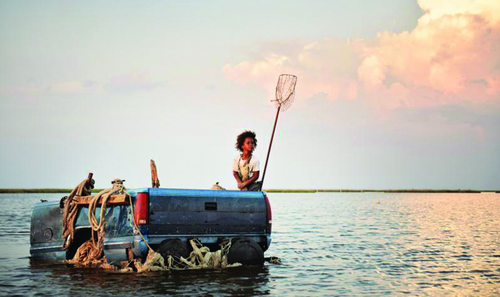
“When it all goes quiet behind my eyes, I see everything that made me flying around in invisible pieces. When I look too hard, it all goes away but when it all goes quiet, I see they are right here. I see that I am a little piece of a big, big universe, and that makes it right.” -Hushpuppy, Beasts of the Southern Wild
- Calmness —– Free-flowing love —– Trust
- Tranquility —– Peace of mind —– Pure essence
- Hope – Serenity —– Inspiration —– Generosity
- Optimism —– Joy —– Faith —– Regeneration
- Good will —– Optimism —– Harmony —– Renewal of forces
Helpful questions for this stage:
• What do I allow to guide me?
• What is the role of nurturing myself and others – is there an imbalance?
• How do I live the connection to nature?
• What can I do to allow more tranquility into my day?
• Am I allowing peace and relaxation to flow through my life?
• How do I acknowledge and take peace from knowing I am a little piece of a big universe?
The Tower – Lightning Liberation
Subscribe in iTunes
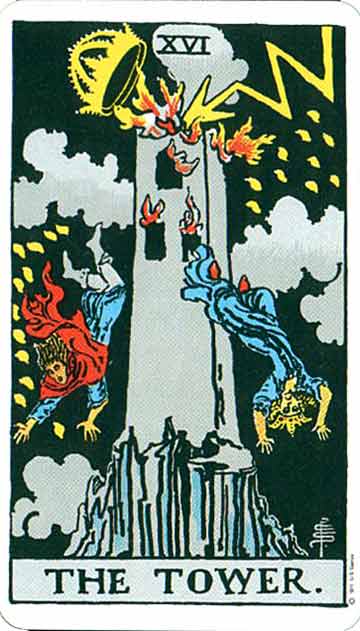
The Rider-Waite Tower card
Questions or suggestions? Email us ATPodcast@archetypist.com
Archetypes related to the Tower card: The Liberator

The Tower from the Marseilles deck
Popular Associations with the Tower Card:
- Chaos —– Sudden change —– Impact —– Hard times
- Crisis —– Revelation —– Disruption —– Realizing the truth
- Disillusion —– Crash —– Burst —– Uncomfortable experience
- Downfall —– Ruin —– Ego blow —– Explosive transformation
Film references for The Tower Card:
Cast Away (2000) Tom Hanks – A FedEx executive is transformed physically and emotionally after a crash landing on a deserted island.
The Hunger Games (2012) – Jennifer Lawrence
The Beasts of The Southern Wild (2012)
Film references for the Liberator archetype:
Lincoln (2012)
Norma Rae (1979)
Religion/Myth: Milarepa – Buddhist Saint who had to rebuild a tower again and again as a part of his karma.
Dancing with the Devil and the Addict
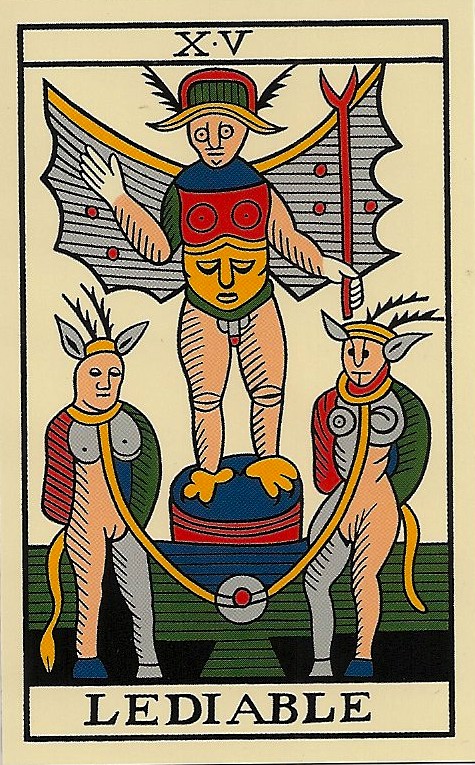
The Devil card of the Marseilles
Listen Now or Subscribe in iTunes
As we enter the last row of our Tarot Journey (and a new year for the Archetypal Tarot Podcast), we are met with the formidable character of The Devil, the fifteenth card of the Major Arcana. Our hero, well on the path to rebirth, must first meet his own shadow and face addictions and attachments.
Julienne Givot and Cyndera Quackenbush also discuss the Pan-like characteristics of the Devil, who invites human beings to recognize their animal natures that rebel when they are suppressed. As always, this podcast adds to your growing movie list with some subtle and interesting studies of the Devil archetype in film.
Archetypes related to the Devil card: Provocateur, Addict, Scapegoat, Addict/Mystic, Perfectionist
Key Words:
- Materialism —– Ignorance —– Stagnation —– Self-bondage
- Lust —– Egoism —– Obsession —– Anxiety —– Anger
- Hedonism —– Passion —– Instincts
- Sexuality —— Temptation —– Doubt —– Vice
- Futility —– Physical attraction —– Pessimism —– Insight
Film References for The Devil Card:
Charlie And The Chocolate Factory (2005) and Willy Wonka and The Chocolate Factory (1971) There are many references to the archetype of the Devil, Provocateur and Addict in these films. Each member of the group (both children and adults) is obsessed with getting something, food (Augustus Gloop), attention (Veruca Salt), being right (Mike Teevee) or even something as innocent as wanting a better life for their family (Charlie). Everyone is tempted and everyone gives in to the temptation, Charlie though is true to the angel of his better nature at the end of the film.
Election (1999) Reeese Whitherspoon & Matthew Broderick.
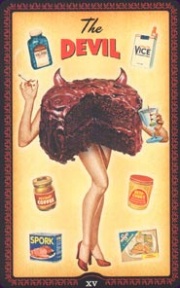
The Housewives tarot Devil card
The Addict archetype:
Every one of us is touched by the Addict archetype. Besides the usual suspects–drugs, alcohol, food, and sex–one can be addicted to work, sports, television, exercise, computer games, spiritual practice, negative attitudes, and the kinds of thrills that bring on adrenaline rushes.
In its positive aspect, this archetype helps you recognize when an outside substance or influence has more authority over your will power than does your inner spirit.
Confronting addiction and breaking the hold that a pattern or substance has on you can impart great strength to your psyche. Discovering the empowerment that comes with perseverance has a life-long impact, “I know now that if I can quit _______, I can do anything.”
From a symbolic perspective, the shadow aspect of the Addict represents a struggle with will power and the absence of self-control. The shadow Addict compromises your integrity and honesty. The shame associated with addiction.
Film References for the Addict archetype:
Natalie Portman – Black Swan (2010)
Ben Stiller – Permanent Midnight (1998)
Ed Harris in Pollock (2000)
Anne Hathaway in Rachel Getting Married (2008)
Robert Downey Jr. in Less Than Zero (1987)
Nicholas Cage and Elizabeth Shue in Leaving Las Vegas (1995)
Leo DiCaprio – The Basketball Diaries (1995)
Religion/Myth: Tantalus he was invited to share the food of the gods but abused the honor and was punished by being “tantalized” for all eternity by food and drink he could not reach).
Temperance – The Angel of Our Better Nature
Subscribe in iTunes or Listen Now
“What we strive for in perfection is not what turns us into the lit angel we desire.” ~David Whyte

Julienne’s rendition of the Temperance card
With a little rest after the Death card the Archetypal Tarot Podcast explores the beginning of the rebirth cycle with Temperance – the fourteenth card of the Major Arcana. Julienne Givot and Cyndera Quackenbush discuss the Angel archetype and the healing and recovery that can take place internally and even below conscious awareness. At the end of our second row, the Realm of Equilibrium, we have a resolution to the ongoing theme of opposites. Here, two elements are alchemized to create “the third thing” that mediates and transforms opposing realities. Listen to the podcast for more on this next step of the journey.
References
Cyndera mentions A Blue Fire by James Hillman specifically chapter 3.
Julienne mentions this related article: Original Fairy Godmother
“I am loath to close. We are not enemies, but friends. We must not be enemies. Though passion may have strained it must not break our bonds of affection. The mystic chords of memory, stretching from every battlefield and patriot grave to every living heart and hearthstone all over this broad land, will yet swell the chorus of the Union, when again touched, as surely they will be, by the better angels of our nature.”
~Abraham Lincoln’s first inaugural address
 Angel & Fairy Godmother/Godfather Archetypes in Films & Television:
Angel & Fairy Godmother/Godfather Archetypes in Films & Television:
-Angels In America – The Play / TV Mini Series (2003)
-Aunt March played by (Mary Wickes) in Little Women (1994)
-It’s A Wonderful Life – Film (1946)
-Danny Glover, Kevin Kline in Grand Canyon (1991)
-Rosalind Russell as Mame Dennis in Auntie Mame (1958)
-Audrey Tatou in Amelie (2001)
-Dustin Hoffmann in Mr. Magorium’s Wonder Emporium (2007)
-Robert DeNiro as Captain Shakespeare in Stardust (2007)
Shadow:
-Marlon Brando in The Godfather trilogy
-Glenn Close in Dangerous Liaisons (1988)
Television:
-Touched by an Angel
-What Not To Wear
Fairy Tales:
-Glinda in The Wonderful Wizard of Oz by L. Frank Baum
The Winter of Listening
By David Whyte
No one but me by the fire,
my hands burning
red in the palms while

Rider-Waite Temperance Card
the night wind carries
everything away outside.
All this petty worry
while the great cloak
of the sky grows dark
and intense
round every living thing.
What is precious
inside us does not
care to be known
by the mind
in ways that diminish
its presence.
What we strive for
in perfection
is not what turns us
into the lit angel
we desire,
what disturbs
and then nourishes
has everything
we need.
What we hate
in ourselves
is what we cannot know
in ourselves but
what is true to the pattern
does not need
to be explained.
Inside everyone
is a great shout of joy
waiting to be born.
Even with the summer
so far off
I feel it grown in me
now and ready
to arrive in the world.
All those years
listening to those
who had
nothing to say.
All those years
forgetting
how everything
has its own voice
to make
itself heard.
All those years
forgetting
how easily
you can belong
to everything
simply by listening.
And the slow
difficulty
of remembering
how everything
is born from
an opposite
and miraculous
otherness.
Silence and winter
has led me to that
otherness.
So let this winter
of listening
be enough
for the new life
I must call my own.
Death – Superstition and Psychology
Listen Now! or Subscribe in iTunes
“We must let go of the life we have planned, so as to accept the one that is waiting for us.” ~Joseph Campbell
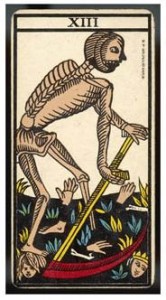 Who knew that Death could be so funny? But here it is, card number 13 in the Major Arcana. Join Julienne and Cyndera as they look at the archetype of Death from a symbolic and psychological point of view with a dash of added humor. Learn why this inevitable stage for the Hero isn’t the end but an important element to the rest of the journey.
Who knew that Death could be so funny? But here it is, card number 13 in the Major Arcana. Join Julienne and Cyndera as they look at the archetype of Death from a symbolic and psychological point of view with a dash of added humor. Learn why this inevitable stage for the Hero isn’t the end but an important element to the rest of the journey.
The Death card liberates all that has reached its end, and cuts away stagnation so that life can continue. Beyond the literal interpretation of this card, there is a rich array of deaths that visit in our daily lives: the end of jobs, relationships and also the visitations of depressions and other forms of “falling apart.” What advantages are there to dismemberment and disintegration? How do Zombies and Batman play a role at exploring this the ultimate mystery of life – it’s end. Or is it the end? You’ll just have to get the podcast and find out.
PS: Listen to all the way to the end for a surprise (and possibly a laugh or two).
Resources Mentioned in the Podcast:
Key Words:
- Ending of a cycle – Loss – Conclusion – Sadness
- Transition into a new state – Psychological transformation
- Finishing up – Regeneration – Elimination of old patterns
- Being caught in the inescapable – Good-byes – Deep change
Film / TV References:
The Dark Knight Rises (2012
Sean of the Dead (2004)
Star Trek II: The Wrath of Khan (1982)
Bones (2005-present)
Dead Like Me (2003-2004)

Julienne’s rendition of Card 13: Death
“Yet through depression we enter depths and in depths find soul. Depression is essential to the tragic sense of life. It moistens the dry soul, and dries the wet. It brings refuge, limitation, focus, gravity, weight, and humble powerlessness. It reminds of death. The true revolution begins in the individual who can be true to his or her depression. Neither jerking oneself out of it, caught in cycles of hope and despair, nor suffering it through till it turns, not theologizing it – but discovering the consciousness and depths it wants. So begins the revolution in behalf of soul.”
~ from Re-Visioning Psychology by James Hillman
The Holy Longing
Tell a wise person, or else keep silent,
because the mass man will mock it right away.
I praise what is truly alive,
what longs to be burned to death.
In the calm water of the love-nights,
where you were begotten, where you have begotten,
a strange feeling comes over you,
when you see the silent candle burning.
Now you are no longer caught in the obsession with darkness,
and a desire for higher love-making sweeps you upward.
Distance does not make you falter.
Now, arriving in magic, flying,
and finally, insane for the light,
you are the butterfly and you are gone.
And so long as you haven’t experienced this: to die and so to grow,
you are only a troubled guest on the dark earth.
Goethe
(translated by Robert Bly)
Like what you heard on the podcast? Share us on Facebook (handy button below) or give us a review on iTunes.
Heart Break Through

photo ©Julienne Givot
Heartbreak is a term most often associated with the unfortunate end of a romantic relationship. It’s also a pervasive pattern that intersects every single human life everywhere. When we hear a friend say, “My heart is broken,” we can relate in an instant without their details. Heartbreak is an archetype that enters our lives on more than one occasion and under differing circumstances but it is not a pattern that organizes a life in the same way that, for example, the Mother does. We don’t meet someone think they were definitely born to for heartbreak. What drives the broken heart is the inability of our expectations to meet the demands of life.
A few years ago, I had my first great experience of heartbreak. The life I thought I would have and where I thought I would be by that time was unfounded and I admitted it. I couldn’t breathe as one image in sequence crashed into the next. I found it hard to stand. In the rubble of my fantasies I fell into despair.
We are forever building cities to our fantasies. We say to ourselves, “I’ll always be with this person,” “I’ll always work here,” “They’ll never die,” and so on. Then the day comes that person doesn’t love us anymore, or we get fired, or that someone dies. One illusion crumbles into another, falling against each other in a long, dusty sequence. Shocked, alternating in loss and denial, we begin a grieving process. We won’t see that the ruin that is our pain is also the opportunity. Whenever we begin something new we have to start with a clear surface to work.
I wandered through my life in the weeks that passed, through the same rooms and spaces I’d known but I wasn’t in them anymore. Whether I was angry at all the time wasted or in denial that the whole fantasy could be resurrected, I was in mourning for the life that had passed away. “Broken heart” became a mantra that I’d repeat to myself and then a visceral experience in my chest. When others saw that something was wrong and asked after it I couldn’t speak to what I was feeling. By myself, I’d weep a great deal. And then I began to ask, “What did break?” I knew I was alive so it could not be my literal heart. Something was broken but if not my heart, then a heart that was never real to begin with. And then there it was: A thrumming in my chest, a sensation that would become a guide back to the present. No longer was I drifting in the past and projecting towards a mythical future. Every motion a moment proceeding steady. With my attention there on my heart, I wasn’t dwelling on what was gone but I stayed here with was already still.
I call the heart that broke was my thimbled heart; cold, hollow, capable of measuring out loves only as much as what was put in, and hard enough to resist intrusion. It didn’t beat much. I had to lay down the remains of my expectations, and in so doing the thimble heart of who I thought I was in order to see what still stood undisturbed.

photo ©Julienne Givot
The magnitude of suffering that quantifies “heartbreak” constitutes a transformational journey, one of such weight and consequence that the issue(s) which began the process cannot be discarded as a measure of coming through the experience and being healed. In fact that would be irresponsible. We don’t leave these things behind, for living bodies carry the scars of the wounds that have been suffered. Only corpses never heal. And let me say that crying on occasion for the person we have been is not an indication that our wounds haven’t healed, but is a signal that our hearts are alive and engaged. If anything we gain the capacity to see the heartbreak in others and a greater compassion for the condition of loss and expectation that beats in all human beings. Born from the tears cried in the suffering of our undesired experiences, a greater heart moves unrelenting. Then it is that we break upon our hearts and breaking open, bear it blazing for all beings everywhere. When we sit with one who is breaking, maybe the best we can offer is a strong witness to the grief they are bearing and allow them their experience. Of all things the greatest helper is time. Perhaps when the broken heart calls once again to visit, we can remember and bring our attention back to what is left as a practical respite from our unbearable grief of letting go.
“Life will break you. Nobody can protect you from that, and living alone won’t either, for solitude will also break you with its yearning. You have to love. You have to feel. It is the reason you are here on earth. You are here to risk your heart. You are here to be swallowed up. And when it happens that you are broken, or betrayed, or left, or hurt, or death brushes near, let yourself sit by an apple tree and listen to the apples falling all around you in heaps, wasting their sweetness. Tell yourself that you tasted as many as you could.”
The Painted Drum by Louise Erdrich
Who are you really? A Halloween Experiment
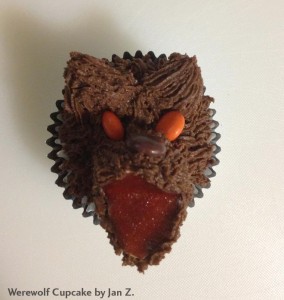
Awesome werewolf cupcake made by my friend Jan.
Halloween is such a great archetypal holiday. What other time do people get to dress up and show their alterna-selves? When my clients are trying to figure which of two similar archetypes fits them the best, I often suggest they try each one on and see how they fit. This is metaphorical but it’s also something one can do more literally by donning a costume. It can also be fun to try on something that is radically different from what you think is the norm for yourself and see how it goes. Halloween is all about this and we have the benefit of stores filled with costume ideas and accessories.
So what will your costume be this year? Does it represent an aspect of who you are or are you trying something different? Costumes can be a great way to explore and express ourselves. Whether you are going in for the whole Halloween costume thing this year (or any other time) try this experiment for some learning fun.
Archetypal Halloween Experiment
1) Visit my Discover Yours page and click the quality that you least identify with. What sort of costumes could you come up with based on the archetypes listed? What sorts of characters have those archetypes? Would you have fun trying on some of those outfits and seeing what would happen?
Next
2) Back on the Discover Yours page click the one quality that you think is the most ‘you’ of all of them. Click to open the box and see what archetypes are there. Could you imagine dressing up in a costume based on one of those listed? What sorts of characters have those archetypes?
Result: My guess is that you have probably dressed up (or thought of dressing up) in probably one from each 1 and 2. Why? We are drawn to what we have an affinity for as well as our opposites. Or I should say perceived opposites.
Carl Jung postulated that all archetypes reside within the collective unconscious and are accessible to everyone. In my practice I use about 12 archetypes with my clients which represent the core patterns they work with throughout their lives. Can we work with more than 12? The answer is yes! I believe along with many other archetypal teachers and researchers that we do work with many, many patterns but some are like situational one offs. For example someone who has the Peacemaker archetype can at times have a need to be a Warrior if circumstances call for it in a situation like defending a loved one. The Warrior might not be a usual archetype the person works with, but it can arise from time to time. Most people have done or said something and wondered “where did that come from?” which I would say is probably a shadow archetype popping up based on the situation. Jung also wrote about the archetype of the Shadow which in essence is the unseen or unacknowledged part of us. The Shadow could contain all sorts of archetypal characters and if you did the experiment above you might have found that one or two cropped up. Many times Shadow is referred to as being bad, but I try not to do that because making a hard judgement about something tends to shut down the learning process.
Have questions or want to post your results? Want some ideas for costumes to go with archetypes? Leave a reply below or shoot me a message!
AT Podcast is Now on Stitcher!
We’re pretty pleased to announce that The Archetypal Tarot Podcast is not available on Stitcher Radio. If you haven’t heard of Stitcher from their sponsorship of many great radio shows like “This American Life” or “RadioLab” let me tell you that it is pretty darn cool and a must for those of us who love talk radio and podcasts. Oh and it’s a free app which you can download from your iPhone/iPad or Android app store.
You can even scroll all the way down to the footer of this page to listen to the most recent episode.
Hang Time and the Martyr
Listen Now! or Subscribe in iTunes
What happened!?! Our hero is hanging upside down! In the thirteenth edition of the Archetypal Tarot Podcast Julienne Givot and Cyndera Quackenbush help to dispel the superstition that often surrounds cards such as The Hanged Man, card number twelve in the Major Arcana. After an exploration of the Hanged Man’s symbolic imagery and the martyr archetype, this podcast illuminates an invitation to test the inner strength gained in the previous card and make valuable sacrifices during this period of “hang time” (yes, a sports reference made its way into the podcast). Also join the discussion of movies featuring the martyr archetype – you may just find a new perspective, or your world turned upside down!
Cyndera also references this animation of a talk by Alan Watts done by the creators of South Park.
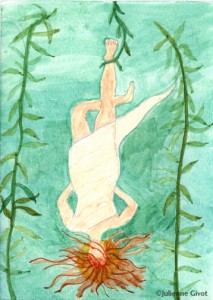
Julienne’s rendition of The Hanged Man
(watercolor on paper)
Julienne’s article goes deeper into the myth and motivation of the Martyr Archetype.
Key Words:
- Sacrifice – Letting go – Surrendering – Passivity
- Suspension – Acceptance – Renunciation – Patience
- New point of view – Contemplation – Inner harmony
- Conformism – Non-action – Waiting – Giving up
Film References:
For the Hanged Man – pay attention to the course that Paul Giamatti’s character takes in The Lady In The Water (2006) as he is pulled out of his self-induced isolation to become a Hero and what he needs to sacrifice to do so.
The Martyr in Film:
Meryl Streep in Silkwood
Ben Kingsley in Gandhi
Sean Penn in Milk
The Martyr in Books:
Little Bee by Chris Cleave
The Happy Prince by Oscar Wilde
Like what you heard on the podcast? Share us on Facebook (handy button below) or give us a review on iTunes.
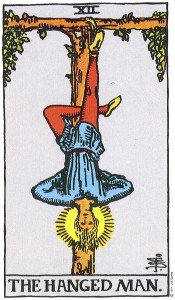
Rider Waite Hanged Man card
Strength Is More Than Muscle
Listen Now! or Subscribe in iTunes
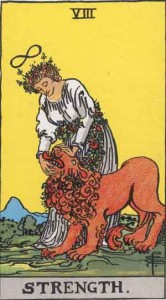
The Strength card as depicted in the Rider Waite deck
The Archetypal Podcast returns from its Summer Sabbatical with its Twelfth Edition starring the eleventh Tarot card, Strength. After a turn on the Wheel of Fortune our Hero/Fool is taken in a new direction and learns from the Lion and Maiden depicted in this card. Inner strength is called for with the knowledge that it’s made up of patience, self-control, and the awareness of one’s instincts and drives. Archetypal Consultant Julienne Givot gives us the breakdown of the empowered and disempowered archetype of the Damsel and reflections on Beauty and the Beast. Tarot Consultant Cyndera Quackenbush regales us with a retelling of an ancient Korean myth about a woman’s lesson in true courage. See below for a written version of the story.
Key Words:
- Fortitude – Lust – Courage – Patience
- Self-control – Being solid – Patience – Compassion
- Composure – Stability – Perseverance – Moderation
- Kindness – Gentleness – Slowness – Softness
- Serenity – Comprehension – Discipline – Inner strength
Film References:
La belle et la bête (Beauty and the Beast) by Jean Cocteau (1946)
Wizard of Oz (The Cowardly Lion and Dorothy) (1939)
Like what you heard on the podcast? Share us on Facebook (handy button below) or give us a review on iTunes.
The Tiger’s Whisker – A Korean Folktale
A young woman came one day to the house of a mountain hermit to seek his help. The hermit was a sage of great renown and a maker of charms and magic potions. When the young woman entered his house, the hermit said, without raising his eyes from the fireplace: “Why are you here?”
She said: “Oh, Famous Sage, I am in distress! My husband, who has just returned from fighting in the wars, hardly speaks to me and is as cold as ice. If he does speak it is with the most explosive fire in his voice! And he no longer enjoys the delicious food that he used savor at our supper table. I want a potion to give my husband so that he will be loving and gentle, as he used to be.””Ha, so simple is it? Can we cure a sick world with a potion?” the hermit said.”Master,” said the woman, if you do not help me, I am truly lost!”
Resigned at last, the hermit said, “Very well; I will help you to make a potion. But it requires an ingredient which I do not possess. The most essential ingredient is a the whisker of a living tiger.”
“The whisker of a living tiger!” She exclaimed. “How will I possibly get that?”
“If the potion is important enough, you will succeed,” the hermit said. He turned his head away, not wishing to talk anymore.
The young woman went home. She thought a great deal about how she would get the tiger’s whisker. Then one night she crept from her house with the most delicious morsels she had cooked especially for her task. She went to the place on the mountainside where the tiger was known to live. Standing far off from the tiger’s cave, she held out the food, calling the tiger to come and eat. The tiger did not come.
The next night She went again with some well-prepared food, this time a bit closer. Again she offered the food to the tiger. Every night she went to the mountain, each time a few steps nearer to the tiger’s cave and even though fear caused her knees to shake she took these footsteps forward.
Little did the young woman know, but the tiger was becoming accustomed to her presence and every night was also creeping closer in her direction. Eventually, one night, the two could see eachother in the moonlight just a stone’s throw apart. It happened again the next night and they were so close she could feel the warmth of the great feline’s breath. As the tiger knelt to eat the food she had given him, She reached out a hand very quickly and plucked a whisker from the Tiger’s face-
And the tiger
pretended
not to notice…
Clutching the whisker tightly in her hand, she backed away slowly, thanking the tiger softly and then went down the path, walking not running, towards the mountain hermit’s house.
“Oh, Famous One!” She cried, ” I have it! I have the tiger’s whisker! Now you can make me the potion you promised so that my husband will be loving and gentle again!”
The hermit took the whisker and examined it, his face alit by the flames of his firepit. Satisfied that it had really come from a tiger, he leaned forward and dropped it into the fire. It vanished immediately in the smoke.
“Oh sir!” the young woman called in anguish. “What have you done!” She proceeded to tell him the story of how patiently, over many weeks she had approached the tiger. “But you have thrown the whisker in the fire! It is all for nothing.”
“No, I do not think it is all for nothing,” explained the hermit. “Is any person more vicious than a tiger? The potion in which you sought was your own courage. You thought you did not have courage because you were afraid of a man. But true courage is being able to feel the fear and still take those steps forward. If you can win the confidence of such a wild creature, surely you can do the same with your husband?”
Hearing this, the young woman stood speechless for a moment. Then she went down the trail, walking but not running, towards home.




